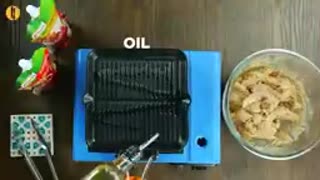Premium Only Content

Food Handler Training Course- Part 3
### **Food Handler Training Course (Part 3) – Preventing Cross-Contamination**
Cross-contamination is a leading cause of foodborne illnesses. It occurs when harmful bacteria, allergens, or other contaminants are transferred from one surface, food, or object to another. As a food handler, understanding and preventing cross-contamination is essential to maintaining food safety.
---
### **Objectives of Part 3**
1. Understand what cross-contamination is and how it occurs.
2. Learn practical steps to prevent cross-contamination.
3. Recognize high-risk foods and critical control points.
---
### **What is Cross-Contamination?**
Cross-contamination happens when harmful microorganisms, allergens, or foreign substances transfer between:
- Foods (e.g., raw to ready-to-eat foods).
- Surfaces and equipment (e.g., cutting boards, utensils).
- People (e.g., hands or clothing).
---
### **Why Cross-Contamination is Dangerous**
1. **Foodborne Illness:**
- Harmful bacteria like Salmonella, E. coli, or Listeria can spread from raw foods to ready-to-eat foods.
2. **Allergen Exposure:**
- Cross-contact can transfer allergens, potentially causing severe allergic reactions.
3. **Regulatory Violations:**
- Failing to prevent cross-contamination can result in penalties and loss of customer trust.
---
### **Common Sources of Cross-Contamination**
1. **Raw Foods:**
- Meat, poultry, seafood, and eggs can carry bacteria that contaminate other foods.
2. **Shared Equipment:**
- Cutting boards, knives, mixers, and other utensils used for multiple tasks.
3. **Hands and Clothing:**
- Hands and clothing can transfer bacteria and allergens between tasks.
4. **Storage Practices:**
- Improper storage of raw and ready-to-eat foods can lead to contamination.
---
### **How to Prevent Cross-Contamination**
#### **1. Separate Raw and Ready-to-Eat Foods**
- Use separate cutting boards and utensils for raw foods and ready-to-eat foods.
- Store raw meats, poultry, and seafood on the bottom shelves of refrigerators to prevent drips onto other foods.
#### **2. Implement Color-Coded Systems**
- Assign specific colors to equipment for different tasks:
- **Red:** Raw meat.
- **Blue:** Raw fish.
- **Green:** Fruits and vegetables.
- **Yellow:** Cooked or ready-to-eat foods.
- **Purple:** Allergen-free foods.
#### **3. Clean and Sanitize Regularly**
- Wash, rinse, and sanitize surfaces, utensils, and equipment after each use.
- Use separate cleaning cloths for raw and ready-to-eat food areas.
#### **4. Practice Good Hand Hygiene**
- Wash hands thoroughly after handling raw foods, touching garbage, or switching tasks.
#### **5. Use Disposable Gloves Correctly**
- Change gloves between tasks, especially after handling raw foods or allergens.
#### **6. Train Staff on Allergen Awareness**
- Educate employees about allergen risks and the importance of avoiding cross-contact.
- Use dedicated tools and storage for allergen-free foods.
---
### **Critical Control Points**
Food handlers should focus on these areas to prevent cross-contamination:
1. **Preparation Areas:**
- Keep raw and cooked food preparation areas separate.
2. **Storage:**
- Store food correctly in the fridge, freezer, and pantry to prevent contamination.
3. **Cooking Equipment:**
- Ensure all equipment is cleaned and sanitized between uses.
---
### **Examples of Safe Practices**
- **Scenario 1:** A chef uses a cutting board for raw chicken and immediately washes, rinses, and sanitizes it before using it for vegetables.
- **Scenario 2:** A baker keeps allergen-free utensils in a separate, labeled drawer to avoid accidental cross-contact.
---
### **Common Mistakes to Avoid**
1. **Reusing Dirty Equipment:**
- Using the same knife or cutting board without cleaning can transfer harmful bacteria.
2. **Improper Storage:**
- Storing raw meat above ready-to-eat foods in the refrigerator is a recipe for contamination.
3. **Touching Food Without Washing Hands:**
- Handling food with dirty hands spreads bacteria quickly.
4. **Not Cleaning Spills Immediately:**
- Leaving spills or drips unattended can contaminate surrounding areas.
---
### **Tips for Success**
- Post signage and reminders in the kitchen to reinforce cross-contamination prevention.
- Conduct regular training and refresher courses for employees.
- Assign supervisors to monitor compliance with food safety protocols.
---
### **Conclusion**
Preventing cross-contamination is a critical responsibility for all food handlers. By following best practices and maintaining a clean and organized workspace, you can minimize risks and ensure food remains safe for consumption.
---
Would you like to proceed to **Part 4: Safe Food Storage** or explore another topic in more detail?
-
 1:35
1:35
HSESafetyInformation
2 months agoMutton Chops two ways- baked & grilled Recipe by Food Fusion (Eid Recipe)
59 -
 8:42
8:42
VSOGunChannel
17 hours ago $2.76 earnedDOJ Attacks the Gun Industry & ATF Gets a New Deputy Director
26.2K15 -
 59:47
59:47
Trumpet Daily
22 hours ago $3.93 earnedKilmar Abrego Garcia: Democrat Poster Child and MS-13 Terrorist - Trumpet Daily | Apr. 17, 2025
24.3K4 -
 8:59
8:59
MudandMunitions
19 hours agoThe Savior Equipment Range Bag: Worth the Hype or Overrated?
29.8K1 -
 3:06:16
3:06:16
Price of Reason
18 hours agoDESPERATE Gavin Newsom SUES Trump! Disney Fantastic Four to FLOP? Asmongold Faces BACKLASH Again!!
157K19 -
 3:48:12
3:48:12
Akademiks
11 hours agoDay 2/30. Drake Challenges UMG and calls them Desperate. Ye Backs Drake. Lil Wayne Dont Fw Superbowl
135K17 -
 8:06:34
8:06:34
MyronGainesX
1 day ago $29.95 earnedKarmelo Anthony Merch, Ashley EXPOSES Elon, Filipino President Punishes Vitaly, Iran War Pause!
102K18 -
 2:41:54
2:41:54
TimcastIRL
14 hours agoMASS SHOOTING At Florida State, Anti Trump Rumors ERUPT, MANGIONE EFFECT w/ Maggie Moda| Timcast IRL
263K176 -
 2:36:29
2:36:29
The Illusion of Consensus
1 day agoExploring Holistic Psychiatry with Dr. Aruna Tammala: Nervous System Regulation, Diet, Supplements, Self-love, and Social Connection
53.7K1 -
 2:44:57
2:44:57
Laura Loomer
13 hours agoEP115: Democrats' Pet Muslims Bite Back
82.6K36